-
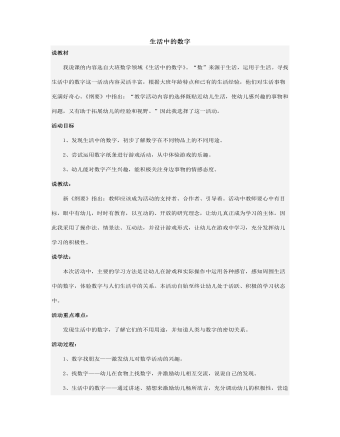
生活中的数字说课稿
1、数字找朋友——激发幼儿对数学活动的兴趣。 2、找数字——幼儿在食物上找数字,并激励幼儿相互交流,说说自己的发现。 3、生活中的数字——通过讲述、猜想来激励幼儿畅所欲言,充分调动幼儿的积极性,营造轻松愉悦的氛围,拓展幼儿已有的生活经验。 4、幸运号码——通过游戏发现数字的趣味性和丰富性,从而更真切的体会数字的神奇,随便的调换数字的位置就可以排成不同的数字组合。 5、设计电话号码——幼儿运用已有的知识解决问题,为自己编电话号码。让没个幼儿参与其中,从而体验成功感,使他们对数字产生极大的兴趣,激励幼儿在生活中主动观察事物和运用数字,为以后学习奠定基础。

关于2023年秦岭生态环境保护前三季度工作总结的报告(1)
二是问题整改再夯责。扎实推进各级各类反馈问题整改,切实扛起问题整改政治责任,细化整改措施,全力加快问题整改。全力完成“五乱”问题整改销号任务,建立健全“五个一”长效机制,对“五乱”问题实行零容忍,坚决扭住不放,露头就打。三是生态价值再深化。按照省市生态产品价值实现机制试点工作总体安排部署,依据《32条措施》和《重点工作任务清单》,积极谋划好全县生态产品价值实现机制试点路径,推动“我在秦岭有宝”微信小程序上线,持续开展绿色创建活动,不断挖掘提炼我县生态产品价值实现典型案例。四是督查检查再发力。要始终保持零容忍的高压态势,严格按照“双查”“快查快处”工作机制,常态化打击秦岭“五乱”行为。不定期开展明察暗访和专项督查倒逼任务落地落实,严肃查处秦岭生态环境保护问题线索,切实发挥考核“指挥棒”作用,不断加大秦岭生态环境保护领域监督执纪问责力度,切实营造风清气正的秦岭生态环境保护工作氛围。
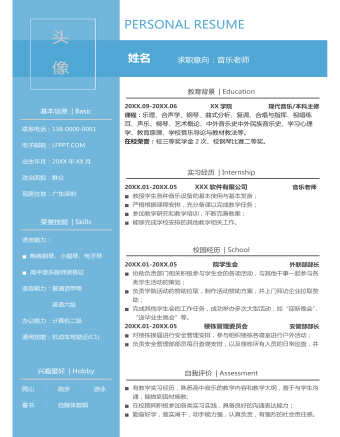
小清新蓝色高中音乐老师求职简历
20XX.01-20XX.05 院学生会 外联部部长n协助负责部门相关积极参与学生会的各项活动,与其他干事一起参与各类学生活动的策划;n负责学院活动的赞助拉取,制作活动赞助方案,并上门拜访企业拉取赞助;n完成其他学生会的工作任务,成功举办多次大型活动,如“迎新晚会”、“送毕业生晚会”等。20XX.01-20XX.05 楼栋管理委员会 安管部部长n对楼栋换届进行安全管理安排,参与组织楼栋各寝室进行户外活动;n负责安全管理部部员每日查寝安排,以及楼栋所有人员的日常巡查,并主持日常开会。
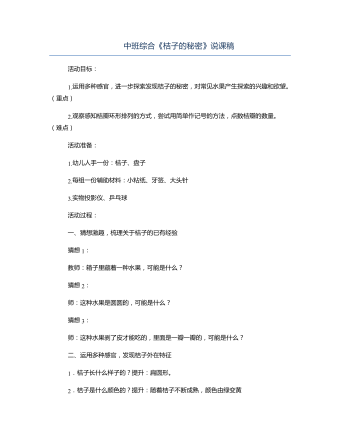
中班综合《桔子的秘密》说课稿
我园地处农村,教育资源十分丰富。充分利用本地资源,开展低成本高质量的教育一直是我们追求的方向。每年秋季,田间、山头高挂枝头的桔子成了孩子生活中最常见、最熟悉的水果。他们在桔园里嘻戏,观察着桔子由绿变黄,和父母老师一起去摘桔子,桔子的清香让他们难忘。孩子们在摸、闻、尝桔子的过程中,充分运用多种感官感知着桔子,他们发现着桔子的特征;当他们把桔子皮剥开来时,他们的手指需要一定的协调性和力量,手部小肌肉群得到发展和锻炼;因此选择桔子这一孩子们身边熟悉的事物作为教学活动的内容,符合《纲要》提出了的“生活化”“兴趣性”原则。然而,面对中班孩子,随着年龄的增加,生活经验的拓展,他们的探究欲望渐渐强烈,在日常生活中他们对桔子的外形特征已有了基本的认识,已经积累了桔子的基本经验,因此选择《桔子》这一教学内容,如果只是一味的重复关于桔子的基本特征,势必造成集体教学活动的无效,因此,我们从孩子的已有经验出发,从桔瓣排列的环形这一点切入,让孩子们通过观察感知,初步尝试“环形数数”。这一集体教学活动旨在通过多通道的感知,游戏化的学习,激发幼儿对生活中常见事物的兴趣。
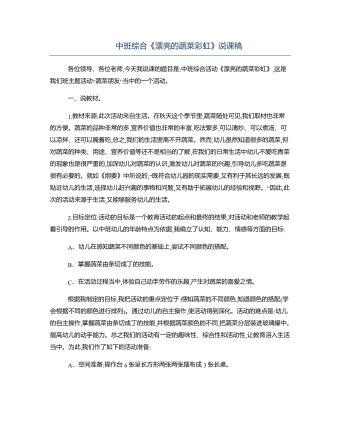
中班综合《漂亮的蔬菜彩虹》说课稿
教材来源:此次活动来自生活。在秋天这个季节里,蔬菜随处可见,我们取材也非常的方便。蔬菜的品种非常的多,营养价值也非常的丰富,吃法繁多,可以清炒、可以煮汤、可以凉拌、还可以腌着吃,总之,我们的生活里离不开蔬菜。然而,幼儿虽然知道很多的蔬菜,但对蔬菜的种类、用途、营养价值等还不是相当的了解,在我们的日常生活中幼儿不爱吃青菜的现象也是很严重的,加深幼儿对蔬菜的认识,激发幼儿对蔬菜的兴趣,引导幼儿多吃蔬菜是很有必要的。就如《纲要》中所说的,“既符合幼儿园的现实需要,又有利于其长远的发展;既贴近幼儿的生活,选择幼儿赶兴趣的事物和问题,又有助于拓展幼儿的经验和视野。”因此,此次的活动来源于生活,又能够服务幼儿的生活。
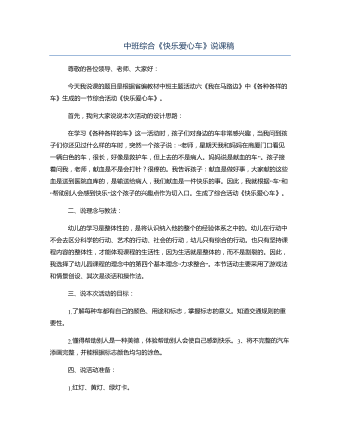
中班综合《快乐爱心车》说课稿
孩子们,转转小脑筋猜个小谜语,孩子们的注意力就集中了起来。我就说出了“车“的谜面:四脚圆滚滚,眼睛亮晶晶,嘀嘀一声叫,招手过路人。我的语气重点在嘀嘀一声叫,孩子马上猜出是汽车。然后就问谁是坐车来的?你坐的车是什么颜色?你做的车大?还是小?引导幼儿懂得车给人们带来了方便,就是车的用途了,幼儿园的车都是黄色的,哪辆车是你坐的?孩子立刻回答自己坐的是1号车或者2号车,这就引出了车是有“标志”的。然后在引导幼儿认识几种常见的特殊车辆,出示110,120,119的车辆,让幼儿分别找出车的标志是什么?它的用途,再让幼儿模仿这几种车跑起来的声音,这时的孩子兴趣很高,都乐意学,嘴里发出(危楼危楼)或者(日日)的声音。
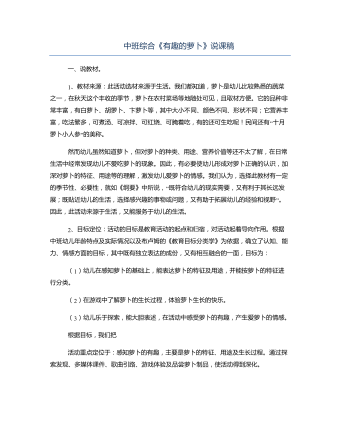
中班综合《有趣的萝卜》说课稿
教材来源:此活动选材来源于生活。我们都知道,萝卜是幼儿比较熟悉的蔬菜之一,在秋天这个丰收的季节,萝卜在农村菜场等地随处可见,且取材方便。它的品种非常丰富,有白萝卜、胡萝卜、卞萝卜等,其中大小不同、颜色不同、形状不同;它营养丰富,吃法繁多,可煮汤、可凉拌、可红烧、可腌着吃,有的还可生吃呢!民间还有“十月萝卜小人参”的美称。然而幼儿虽然知道萝卜,但对萝卜的种类、用途、营养价值等还不太了解,在日常生活中经常发现幼儿不爱吃萝卜的现象。因此,有必要使幼儿形成对萝卜正确的认识,加深对萝卜的特征、用途等的理解,激发幼儿爱萝卜的情感。我们认为,选择此教材有一定的季节性、必要性,就如《纲要》中所说,“既符合幼儿的现实需要,又有利于其长远发展;既贴近幼儿的生活,选择感兴趣的事物或问题,又有助于拓展幼儿的经验和视野”。因此,此活动来源于生活,又能服务于幼儿的生活。
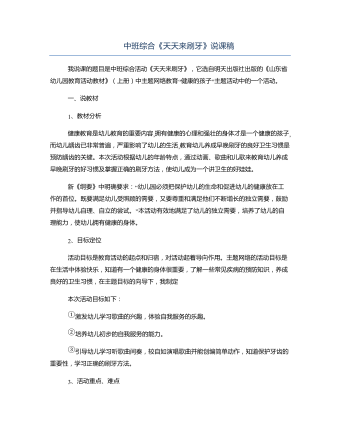
中班综合《天天来刷牙》说课稿
健康教育是幼儿教育的重要内容,拥有健康的心理和强壮的身体才是一个健康的孩子,而幼儿龋齿已非常普遍,严重影响了幼儿的生活,教育幼儿养成早晚刷牙的良好卫生习惯是预防龋齿的关键。本次活动根据幼儿的年龄特点,通过动画、歌曲和儿歌来教育幼儿养成早晚刷牙的好习惯及掌握正确的刷牙方法,使幼儿成为一个讲卫生的好娃娃。新《纲要》中明确要求:“幼儿园必须把保护幼儿的生命和促进幼儿的健康放在工作的首位。既要满足幼儿受照顾的需要,又要尊重和满足他们不断增长的独立需要,鼓励并指导幼儿自理、自立的尝试。”本活动有效地满足了幼儿的独立需要,培养了幼儿的自理能力,使幼儿拥有健康的身体。

新人教版高中英语必修3Unit 2 Morals and Virtues-Discovering Useful Structure教学设计
1. 表示时间。Hearing these stories, I’m skeptical about the place. = When I heard these stories. . . 2. 表示原因。Not knowing his address, I can’t send this book to him. = Because/Since/As I don’t know his address. . . 3. 表示结果。His father died, leaving him a lot of money. =. . . and left him a lot of money4. 表示条件。Going straight down the road, you will find the department store. = If you go straight down the road. . . 5. 表示让步。Being tired, they went on working. =Although they were tired. . . 6. 表示行为方式、伴随情况或补充说明。He lay on the grass, staring at the sky for a long time. =. . . and stared at the sky for a long time注意:非谓语动词作状语时, 如所提供的动词不能和句子中的主语保持一致, 动词-ing形式必须有自己的逻辑主语, 通常由名词或代词来担任, 这就是独立主格结构。The last bus having gone, we had to walk home. (having gone的逻辑主语是the last bus, 而不是we)Weather permitting, the football match will be played on Friday. (permitting的逻辑主语是time, 而不是the football match)Step 7 Practice1. ________(study) hard, you are sure to get first prize. 2. People use plastic in their daily life, _______(leave) large amounts of waste. 3. ________(work) hard at your lessons, you are to succeed. 4. The old man, ____________(work) abroad for twenty years, is on the way back to his motherland. 5. ______________(finish) his homework, he was playing on the playground. Answers: 1. Studying 2. leaving 3. Working 4.having worked 5. Having finishedStep 8 HomeworkFinish the homework on Page 22.
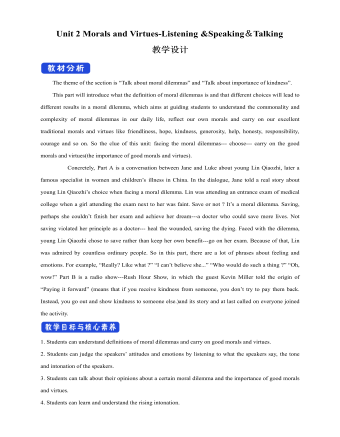
新人教版高中英语必修3Unit 2 Morals and Virtues-Listening &Speaking&Talking教学设计
Example:One day, a poor boy who was trying to pay his way through school by sending newspapers door to door found that he only had one dime(一角)left. He was so hungry that he decided to beg for a meal at the next house.However, he lost his nerve when a lovely young woman opened the door. Instead of a meal he asked for a drink of water. She thought he looked hungry so she brought him a large glass of milk. He drank it slowly, and then asked, “How much do I owe you?” “You don’t owe me anything,” she replied, “Mother has taught me never to accept pay for a kindness.” “Then I thank you from the bottom of my heart.” With these words, Howard Kelly left that house.Years later the woman became badly ill and was finally sent to the hospital in a big city. Dr. Howard Kelly, now famous, was called in. When he heard the name of the town she came from, a strange light filled his eyes. Dressed in his doctor’s clothes, Dr. Kelly went into her room and recognized her at once. From that day on, he gave special attention to her, and decided to do his best to save her life.At last the woman was saved. Dr. Kelly asked the business office to pass the final bill to him. He looked at it and then wrote something on the side. The bill was sent to the woman’s room. She was afraid to open it because she was sure that it would take the rest of her life to pay for it off. Finally she looked, and the note on the side of the bill caught her attention. She read these words: “Paid in full with a glass of milk, Dr. Howard Kelly.” Tear of joy flooded her eyes.

新人教版高中英语必修3Unit 2 Morals and Virtues-Reading and Thinking教学设计
The topic of this part is “Learn to make choices in life”.The Listening & Speaking & Talking part aims at the moral dilemmas, and this part is about making choices in life. The heroin is Lin Qiaozhi, a famous medical scientist, made a great contribution to our country’s medical care. Most importantly, her life experience can inspire our students whether in studying or the development of career. she had moral dilemmas and life choices, which are similar to the students who will step into society. Besides, Lin has quite good virtues like kindness, self-improvement, insistence, job-loving , generosity and responsibility, which is worth being learned.Concretely, this article is a biography about Lin Qiaozhi. The article tells her whole life according the timeline, among which the life choices is emphasized. For example, whether married or chased her dream, returned home or stayed abroad, family or public, her choices all reflected her faith, spirit, responsibility and devotion.1. Fast reading to get the detailed information about Lin Qiaozhi; careful reading to do the deductive information.2. Learn the reading skills--deductive judgement according the context.3. Study the structure features and language features. 4. Communicate about Lin’s life choices and reflect their own life choices.1. Learn the reading skills--deductive judgement according the context.2. Study the structure features and language features.3. Communicate about Lin’s life choices and reflect their own life choices.Step 1 Lead in---Small talkWhat are some important life choices?Importance choices: university study, jobs and marriage partners. Because they can determine our future.
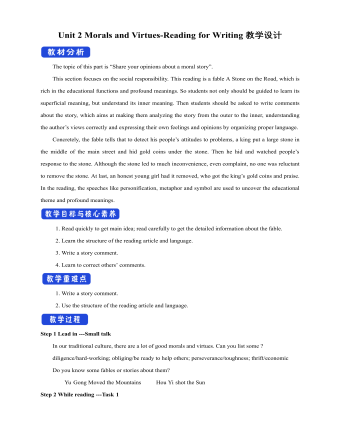
新人教版高中英语必修3Unit 2 Morals and Virtues-Reading for Writing教学设计
1. 这个寓言是一个关于一位国王古寓言。 The fable is an old fable about a king.2.作者用这个故事让读者对于社区的问题负有个人责任的必要印象深刻。The author used the story to impress upon readers with the need to take personal responsibility for problems in the community.3. 这个故事十分成功的实现了它的目的。The story was quite successful in achieving its purpose.Step 7 WritingPlease write a review of the story according the outline above.The fable is an old fable about a king who thought his people are lazy, so he put a large stone in the middle of the road and hides and waited to see if anyone will try to move it.The author used this story to impress upon readers with the need to take personal responsibility for problems in the community. The story was quite successful in achieving its purpose, and I liked it because it had a clear moral.However, while the moral of the story is clear, the actions of the king seemed pointless to me, because none of the characters in the story learnt anything. For this reason, I think there are better stories that can be used to impress upon people with the need for personal responsibility.Step 8 Pair workExchange drafts with a partner. Use this checklist to help your partner revise his/her draft.1. Does the writer give a short description of the story ?2. Does the description include the most important details of the story ?3. Does the writer give his or her opinion about the character or their actions ?4. Is the review well-organised ? 5. Does the writer use the -ing form as the adverbial correctly in the writing ?6. Are there any grammar, spelling, or punctuation errors ?Step 9 HomeworkPut up your revised draft in the classroom or read it to your class.

新人教版高中英语必修3Unit 3 Diverse Cultures-Discovering Useful Structure教学设计
Step 4 PracticeRead the conversation. Find out which words have been left out.Justin: Linlin, I’m going to Guizhou Province next month. I’m super excited! Any recommendations for places to visit?Linlin: Wow, cool! Guizhou is a province with a lot of cultural diversity. Places to visit...well, definitely the Huangguoshu Waterfall first.Justin: What’s special about the waterfall?Linlin: Well, have you ever heard of the Chinese novel Journey to the West ?Justin: Yes, I have. Why ?Linlin: In the back of the waterfall, you will find a cave, which is the home of the Monkey King.Justin: Really? Cool! I’ll definitely check it out.Linlin:And I strongly recommend the ethnic minority villages. You’ll find Chinese culture is much more diverse than you thought.Justin:Sounds great, thanks.Answers:Justin: Linlin, I’m going to Guizhou Province next month. I’m super excited! Do you have any recommendations for places to visit?Linlin: Wow, that’s cool! Guizhou is a province with a lot of cultural diversity. What are some places to visit in Guizhou ? Well, definitely the Huangguoshu Waterfall is the first place to visit in Guizhou Province.Justin: What’s special about the waterfall?Linlin: Well, have you ever heard of the Chinese novel Journey to the West ?Justin: Yes, I have heard of the Chinese novel Journey to the West . Why do you ask if I have heard of the Chinese novel Journey to the West?Linlin: In the back of the waterfall, you will find a cave, which is the home of the Monkey King from Journey to the West.Justin: That’s really true? It’s Cool! I’ll definitely check it out.Linlin:And I strongly recommend the ethnic minority villages on your trip to Guizhou Province. You’ll find Chinese culture is much more diverse than you thought it was.Justin:This all sounds great, thanks.
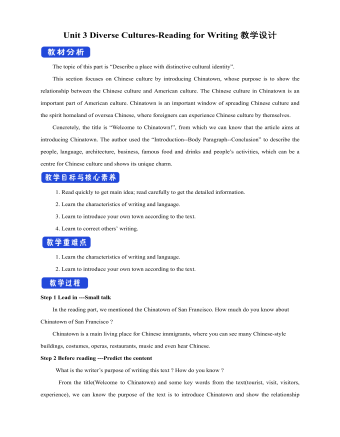
新人教版高中英语必修3Unit 3 Diverse Cultures-Reading for Writing教学设计
The topic of this part is “Describe a place with distinctive cultural identity”.This section focuses on Chinese culture by introducing Chinatown, whose purpose is to show the relationship between the Chinese culture and American culture. The Chinese culture in Chinatown is an important part of American culture. Chinatown is an important window of spreading Chinese culture and the spirit homeland of oversea Chinese, where foreigners can experience Chinese culture by themselves.Concretely, the title is “Welcome to Chinatown!”, from which we can know that the article aims at introducing Chinatown. The author used the “Introduction--Body Paragraph--Conclusion” to describe the people, language, architecture, business, famous food and drinks and people’s activities, which can be a centre for Chinese culture and shows its unique charm.1. Read quickly to get main idea; read carefully to get the detailed information.2. Learn the characteristics of writing and language.3. Learn to introduce your own town according to the text.4. Learn to correct others’ writing.1. Learn the characteristics of writing and language.2. Learn to introduce your own town according to the text.Step 1 Lead in ---Small talkIn the reading part, we mentioned the Chinatown of San Francisco. How much do you know about Chinatown of San Francisco ?Chinatown is a main living place for Chinese immigrants, where you can see many Chinese-style buildings, costumes, operas, restaurants, music and even hear Chinese.Step 2 Before reading ---Predict the contentWhat is the writer’s purpose of writing this text ? How do you know ?From the title(Welcome to Chinatown) and some key words from the text(tourist, visit, visitors, experience), we can know the purpose of the text is to introduce Chinatown and show the relationship between Chinese culture and American culture.
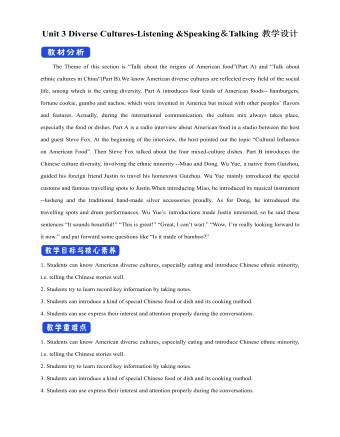
新人教版高中英语必修3Unit 3 Diverse Cultures-Listening &Speaking&Talking教学设计
1. In Picture 1 and Picture 2, where do you think they are from? How do you know?From their wearings, we can know they are from ethnic minority of China--- Miao and Dong.Picture 1, they are playing their traditional instrument lusheng in their traditional costumes.Picture 2. the girls are Miao because they wear their traditional costumes and silver accessory.2. In Picture 3, can you find which village it is? What time is it in the picture?It is Dong village. It is at night. Step 2 While-listeningJustin met a new friend while traveling in Guizhou. Listen to their conversation and complete the summaries below.Part 1Justin and Wu Yue watched some Miao people play the lusheng. The instrument has a history of over 3,000 years and it is even mentioned in the oldest collection of Chinese poetry. Then they watched the lusheng dance. Justin wanted to buy some hand-made silver/traditional accessories as souvenirs. He was told that the price will depend on the percentage of silver. Part 2They will go to a pretty Dong minority village called Zhaoxing. they will see the drum towers and the wind and rain bridges. They may also see a performance of the Grand Song of the Dong people.Step 3 Post-listening---TalkingWork in groups. Imagine Justin is telling some friends about his trip to Guizhou. One of you is Justin and the rest of you are his friends. Ask Justin questions about his trip and experience. The following expressions may help you.
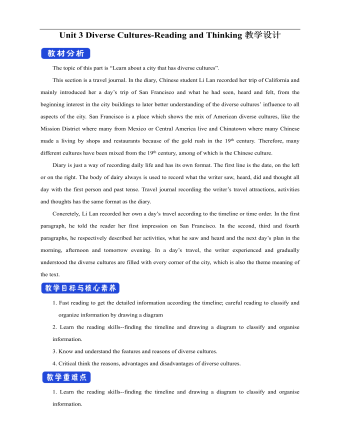
新人教版高中英语必修3Unit 3 Diverse Cultures-Reading and Thinking教学设计
Discuss these questions in groups.Q1: Have you ever been to a place that has a diverse culture ? What do you think about the culture diversity ?One culturally diverse place that I have been to is Harbin, the capital city of Heilongjiang Province. I went there last year with my family to see the Ice and Snow Festival, and I was amazed at how the culture as different to most other Chinese cities. There is a big Russian influence there, with beautiful Russian architecture and lots of interesting restaurants. I learnt that Harbin is called “the Oriental Moscow” and that many Russians settled there to help build the railway over 100 years ago.Q2: What are the benefits and challenges of cultural diversity ?The benefits: People are able to experience a wide variety of cultures, making their lives more interesting, and it can deepen the feelings for our national culture, it is also helpful for us to learn about other outstanding culture, which helps improve the ability to respect others. The challenges: People may have trouble communicating or understanding each other, and it may lead to disappearance of some civilizations and even make some people think “The western moon is rounder than his own.”Step 7 Post reading---RetellComplete the passage according to the text.Today, I arrived back in San Francisco, and it feels good (1) _____(be) back in the city again. The city succeeded in (2)_________ (rebuild) itself after the earthquake that (3)________ (occur) in 1906, and I stayed in the Mission District, enjoying some delicious noodles mixed with cultures. In the afternoon, I headed to a local museum (4)____ showed the historical changes in California. During the gold rush, many Chinese arrived, and some opened up shops and restaurants in Chinatown to earn a (5)_____ (live). Many others worked on (6)______ (farm), joined the gold rush, or went to build the railway that connected California to the east. The museum showed us (7)____ America was built by immigrants from (8)________ (difference) countries and cultures. In the evening, I went to Chinatown, and ate in a Cantonese restaurant that served food on (9)________(beauty) china plates. Tomorrow evening, I’m going to (10)__ jazz bar in the Richmond District. 答案:1. to be 2. rebuilding 3. occurred 4. that 5.living6. farms 7.how 8. different 9. beautiful 10. a

新人教版高中英语必修3Unit 4 Space Exploration-Listening&Speaking&Talking教学设计一
Listening and Speaking introduces the topic of “talking about how to become an astronaut”. This period is aimed to inform students some details about the requirements of being an astronaut. Students can be motivated and inspired by the astronauts. Teachers ought to encourage students to learn from them and let them aim high and dream big.Listening and Talking introduces the theme of "talk about life in space". This part also informs students more details about life in space and can inspire students to be curious about this job. 1. Guide students to listen for numbers concerning dates, years and ages etc2. Cultivate students' ability to talk about how to become an astronaut and life in space ; 3. Instruct students to use functional sentences of the dialogue such as “ first of all, I am not sure, so what might be .. I guess.. I wonder…I am curious…)appropriately.1. Guide students to understand the content of listening texts in terms of the whole and key details; 2. Cultivate students' ability to guess the meaning of words in listening; discuss with their peers how to become a qualified astronaut and describe the life in space.Part 1: Listening and SpeakingStep 1: Lead inPredictionThe teacher can ask students to predict what the listening text is about by looking at the pictures.About how to become an astronaut./the requirements of an astronautStep 2: Then, play the radio which is about an interview a. And after finishing listening for the first time, the students need to solve the following tasks.

新人教版高中英语必修3Unit 4 Space Exploration-Discovering Useful Structure教学设计
The theme of the section is “Describe space facts and efforts to explore space”. Infinitives are one of non-finite verbs, as the subjects, objects, predicative, attributes and adverbials. This unit is about space exploration, which is a significant scientific activity, so every scientific activity has strong planning. Therefore, using the infinitives to show its purpose, explanations or restrictions is the best choice.1. Learn the structure, functions and features of infinitives.2. Learn to summarize some rules about infinitives to show purpose and modify.3. Learn to use infinitives in oral and writing English. 1. Learn the structure, functions and features of infinitives.2. Learn to summarize some rules about infinitives to show purpose and modify.3. Learn to use use infinitives in oral and writing English.Step 1 Lead in---Pair workLook at the following sentences and focus on the italicized infinitives. In pairs, discuss their functions. 1. I trained for a long time to fly airplanes as a fighter pilot..(作目的状语)2. As we all know, an astronaut needs to be healthy and calm in order to work in space..(作目的状语)3. First of all, you must be intelligent enough to get a related college degree..(作目的状语)4. Some scientist were determined to help humans realise their dream to explore space..(作定语)5. On 12 April 1961, Yuri Gagarin became the first person in the world to go into space..(作定语)Summary:1. 不定式的结构:to+do原形。2. 分析上面的句子,我们知道在描述太空探索时,动词不定式不仅可以用来表目的,还可以用来作定语,表修饰。
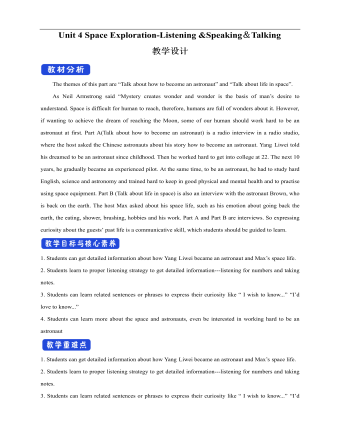
新人教版高中英语必修3Unit 4 Space Exploration-Listening&Speaking&Talking教学设计二
The themes of this part are “Talk about how to become an astronaut” and “Talk about life in space”. As Neil Armstrong said “Mystery creates wonder and wonder is the basis of man’s desire to understand. Space is difficult for human to reach, therefore, humans are full of wonders about it. However, if wanting to achieve the dream of reaching the Moon, some of our human should work hard to be an astronaut at first. Part A(Talk about how to become an astronaut) is a radio interview in a radio studio, where the host asked the Chinese astronauts about his story how to become an astronaut. Yang Liwei told his dreamed to be an astronaut since childhood. Then he worked hard to get into college at 22. The next 10 years, he gradually became an experienced pilot. At the same time, to be an astronaut, he had to study hard English, science and astronomy and trained hard to keep in good physical and mental health and to practise using space equipment. Part B (Talk about life in space) is also an interview with the astronaut Brown, who is back on the earth. The host Max asked about his space life, such as his emotion about going back the earth, the eating, shower, brushing, hobbies and his work. Part A and Part B are interviews. So expressing curiosity about the guests’ past life is a communicative skill, which students should be guided to learn.1. Students can get detailed information about how Yang Liwei became an astronaut and Max’s space life.2. Students learn to proper listening strategy to get detailed information---listening for numbers and taking notes.3. Students can learn related sentences or phrases to express their curiosity like “ I wish to know...” “I’d love to know...”4. Students can learn more about the space and astronauts, even be interested in working hard to be an astronaut
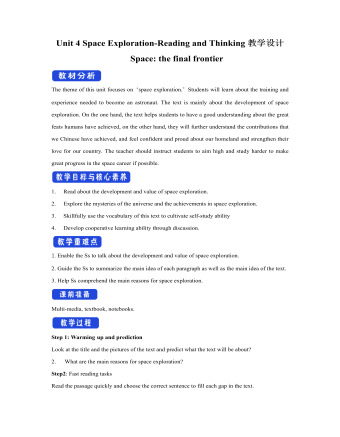
新人教版高中英语必修3Unit 4 Space Exploration-Reading and Thinking教学设计二
The theme of this unit focuses on “space exploration.” Students will learn about the training and experience needed to become an astronaut. The text is mainly about the development of space exploration. On the one hand, the text helps students to have a good understanding about the great feats humans have achieved, on the other hand, they will further understand the contributions that we Chinese have achieved, and feel confident and proud about our homeland and strengthen their love for our country. The teacher should instruct students to aim high and study harder to make great progress in the space career if possible.1. Read about the development and value of space exploration.2. Explore the mysteries of the universe and the achievements in space exploration.3. Skillfully use the vocabulary of this text to cultivate self-study ability 4. Develop cooperative learning ability through discussion.1. Enable the Ss to talk about the development and value of space exploration.2. Guide the Ss to summarize the main idea of each paragraph as well as the main idea of the text.3. Help Ss comprehend the main reasons for space exploration. Multi-media, textbook, notebooks.Step 1: Warming up and predictionLook at the title and the pictures of the text and predict what the text will be about?2. What are the main reasons for space exploration?
